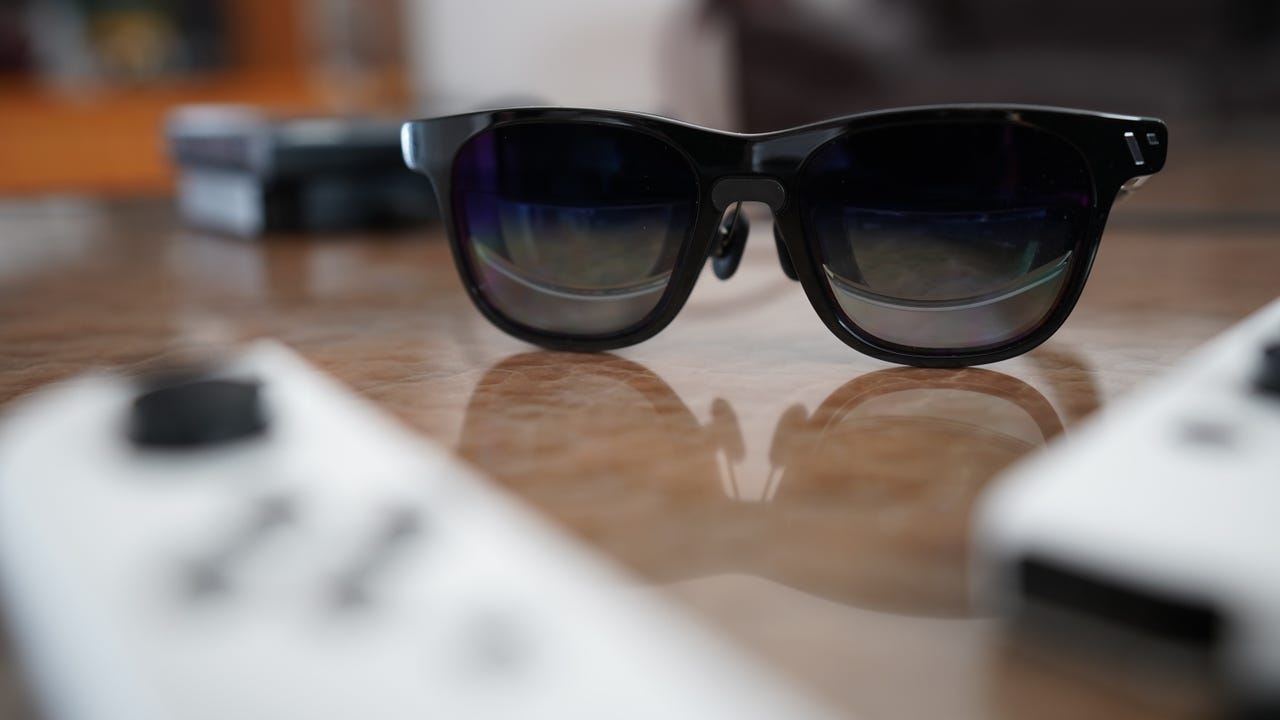These $400 XR glasses gave my MacBook a 120-inch screen to work with

As I make my way to the back of the commuter bus, I pull out what looks like an ordinary pair of sunglasses (with only slightly thicker sides), connect its MagSafe-like power adapter to my MacBook, sit, and start to click, drag, scroll, and type.
Also: I tried Apple Vision Pro and it's far ahead of where I expected
From a bystander's view, I look like the mightiest of keyboard warriors, churning out bodies of text without ever needing to look down at the QWERTY layout on my laptop. From my view, I'm staring at a 120-inch display projected two feet in front of me thanks to a meticulous arrangement of light and mirrors within the “sunglasses.”
They're called Viture One XR Glasses, and instead of transmitting you into a virtual or augmented reality like Apple's new Vision Pro headset, these wearables simply extend from — and are powered by — the source they're connected to, serving as an ultraportable, on-your-face monitor. Oh, and they cost $439 a pop which, after last week's WWDC news, seems much easier to swallow.
ZDNET RECOMMENDS
Viture One XR Glasses
These extended-reality glasses can display a 120-inch projection of the software they're tethered to.
To be clear, comparing the XR Glasses to a $3,500 productivity wearable is an apples-to-oranges contest. Unless you consider yourself an early adopter, the target customers of the two gadgets are notably different.
Viture is pitching its glasses to people who want to game, watch movies, or surf the web without needing to be physically in front of a TV or office desk. The glasses' 120-inch projection is more suited for folks who would rather binge-watch shows while lying in bed, or are on a flight and seek privacy when using a phone, tablet, or laptop.
Also: Best portable monitors (and what screen size fits your needs)
My use case slots right in between: I want a larger platform to draft news and reviews and answer secretive emails as I sit in the make-believe comfort of public transit. The glasses are also practical for when your partner wants to watch The Bachelor on the living room TV, but you're more interested in the marriage of basketball and the spirit of competition. I'm just saying.
A mock-up of what it looks like to wear the Viture glasses. June Wan/ZDNET
Thanks to the single USB-C cable needed to power the device, I can easily pair the Viture glasses to my MacBook or Android phone. Bonus points if the latter is a Samsung Galaxy that supports DeX mode or Motorola that supports Ready For; in those two platforms, you'll be greeted with a desktop interface of your usual mobile apps and services.
As far as the visual experience of the glasses goes, it's adequate, but nothing groundbreaking. For prescription wearers like myself, there are two Myopia rotary knobs (think focus dials) on the top of the Viture One that can be adjusted to your vision. That means you don't have to, and shouldn't, wear the XR glasses over your existing pair.
Also: How to easily toggle MacOS Stage Manager on and off for maximum efficiency
I found the best way to calibrate this was to keep the opposite eye closed as I was tuning each side. However, finding the perfect focus will take some trial and error, and even when you think you've struck the right distance, the corners and edges of the 120-inch projection will remain blurry.
That seems to be unavoidable due to how large but close the visual is to your eyes. For example, if you hold an object an inch from your eyes, you'll notice how difficult it is to focus on it.
Still, Viture has integrated some clever mechanisms with the lenses, like a self-dimming electrochromic film that you can toggle on or off depending on how bright your environment is. It's basically a built-in projector shade and helps the most when you're using the glasses outdoors.
My best attempt at capturing what's shown when the glasses are worn. June Wan/ZDNET
Viture partnered with Harman to develop and tune the side-firing speakers of the wearable, and I'm impressed. They remind me a lot of bone-conduction headphones where audio beams against the side of your head and into your ears. Since the speakers are laying against you, no one but you can hear the audio output, which adds to the privacy focus that the company is going for.
Perhaps the biggest question with such wearables is whether or not they cause symptoms of dizziness and motion sickness. From my experience, which includes one- to two-hour stints, I never felt discomfort when using the glasses.
Also: Are VR headsets safe for kids and teenagers? Here's what the experts say
I credit that to two factors: the lightness of the wearable compared to traditional headsets and the wearer's ability to retain spatial awareness. Remember, the glasses are not a standalone device with its own operating system. They're simply an external monitor reshaped into something more pocketable. And thanks to the transparency of the lenses, you'll never feel like you're drawn into another reality when you have them on.
At the time of writing, the Viture One XR Glasses are selling for $439, and that includes the power adapter, a carrying case, and nose pads in various heights. For the price, I'd recommend these to traveling professionals, gamers, and those who want a more private but accessible display experience. They won't beat the Meta Quest 2 or scratch your itch for the Vision Pro, but the ability to whip out a 120-inch screen no matter where you are may be enough to sell you on Viture's promise.

